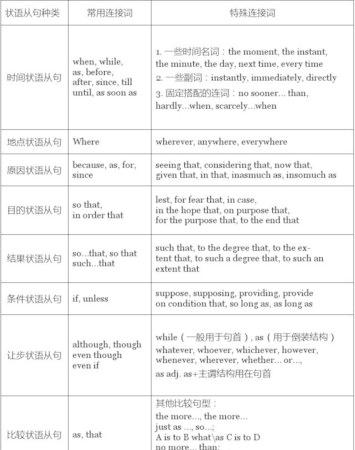状语从句是英语中的重要语法结构,用于描述事件的条件、时间、原因和结果。常用的状语从句句型包括时间状语从句(如"When I was young"),条件状语从句(如"If it rains tomorrow"),原因状语从句(如"Because it was raining outside")和结果状语从句(如"So I was late for work")。熟练掌握这些句型可以帮助理解和准确表达英语句子。

时间状语从句
时间状语从句用来描述一个事件发生的时间,以下是一些常用的时间状语从句句型:
- When + 主语 + 谓语:当……时候,例如:"When I was young, I used to play soccer every day."
- While + 主语 + 谓语:当……的时候,例如:"While I was walking to work, I saw a beautiful flower."
- Before/After + 主语 + 谓语:在……之前/之后,例如:"Before I go to bed, I brush my teeth."
- As soon as + 主语 + 谓语:一……就,例如:"As soon as I finish my work, I will go to the gym."
条件状语从句
条件状语从句用来描述一个事件发生的条件,以下是一些常用的条件状语从句句型:
- If + 主语 + 谓语:如果……,例如:"If it rains tomorrow, I will stay at home."
- Unless + 主语 + 谓语:除非……,例如:"Unless you study hard, you won't pass the exam."
- Provided that + 主语 + 谓语:只要……,例如:"Provided that you finish your work, you can go home early."
- In case + 主语 + 谓语:万一……,例如:"In case you get lost, call me."
原因状语从句
原因状语从句用来描述一个事件发生的原因,以下是一些常用的原因状语从句句型:
- Because + 主语 + 谓语:因为……,例如:"I stayed at home because it was raining outside."
- Since + 主语 + 谓语:既然……,例如:"Since you are here, let's have dinner together."
- As + 主语 + 谓语:由于……,例如:"As I was feeling tired, I decided to take a nap."
- Now that + 主语 + 谓语:既然……,例如:"Now that you have finished your work, you can go home."
结果状语从句
结果状语从句用来描述一个事件发生的结果,以下是一些常用的结果状语从句句型:
- So + 主语 + 谓语:因此……,例如:"I missed the bus, so I was late for work."
- Such + 名词 + that + 主语 + 谓语:如此……以至于……,例如:"It was such a beautiful day that we decided to go for a picnic."
- Therefore + 主语 + 谓语:因此……,例如:"I didn't study hard, therefore I failed the exam."
- Consequently + 主语 + 谓语:因此……,例如:"I didn't have enough sleep, consequently I felt tired all day."

